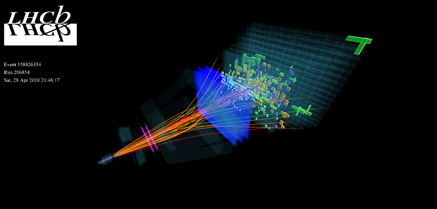The 2018 data taking period started officially today. The last 2017 proton-proton collisions took place on 28 November and the LHC machine was shut down during the winter period to allow for planned technical interventions. LHCb used this period to perform maintenance work on many sub-detectors.
Four months later proton beams passed again through the LHCb detector. The nominal proton beam has size of a human hair and an energy equivalent to a very fast train. The commissioning of LHC is therefore very complicated and takes about one month. First collisions with very low intensity beams took place on 12 April and the LHC experts were able to declare “Stable Beams” condition on 17 April. Once the “Stable Beams” condition is declared, the LHC operators keep the well focussed colliding beams on their stable orbits, which allows the experiments to switch on their sensitive detectors and start to safely record proton-proton collisions. Each beam consists of packets of protons called bunches. The number of proton bunches was progressively increased and will finally reach the maximum of 2556 bunches of which 2332 will collide inside the LHCb detector. The low intensity collisions are used for detector commissioning and therefore it is not evident at which moment experiments can call the official “start of data taking” used for physics analysis. The LHC operation team and LHC experiments agreed this year that this important milestone will be reached when 1200 proton bunches in each beam will collide. This has happened today.
The re-commissioning of the accelerator has proceeded very smoothly and first collisions arrived earlier than initially expected. The LHCb detector and its data acquisition system are ready for the last year of Run 2 data taking that will allow the experiment to obtain even more precise and interesting physics results. Follow LHCb data taking by watching live event display as well as live LHC and LHCb status pages. The image displays a typical event recorded today. The two-year Long Shutdown 2 will then start in December 2018, and during this period the LHCb detector will face its first major upgrade, which will allow the experiment to take data at much higher rate.
Click the image for higher resolution.

